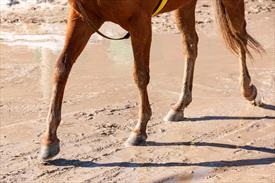Bob Judd, DVM, DABVP (Equine Medicine), DABVP (Canine and Feline Practice)
Horse legs on sand

Dr. Nancy S. Loving, DVM, author at the publication The Horse, writes that healthy hooves are especially important if your horse has arthritic joints. Trimming and shoeing techniques can alter a horse’s biomechanics and make the horse more painful or can lessen the pain from arthritis.
Horses with arthritis try to shorten their stride to reduce the load on the arthritic joints, and it is believed the pain is associated with the concussion of impact and extreme range of motion.
Materials that decrease the impact on the foot, like soft sand, custom arena footing, or specialty shoeing materials, can decrease pain on impact. When picking up your arthritic horse’s leg, be aware of the range of motion and decrease it as much as possible. Many horses have an increased range of motion when the range of motion is exceeded, which is why veterinarians perform flexion tests on horses when evaluating lameness.
Rolling the toe has been shown to decrease breakover, making it easier and quicker to get the foot off the ground and decreasing pain.
Another concern is hoof balance. This term is difficult to define, but the hoof may be imbalanced if the coronary band is asymmetrical. This shows that the foot is not growing symmetrically. The side of the hoof wall with the most load has decreased growth and is complicating the issue.
Unbalanced hooves can lead to arthritis due to excessive pressure on specific areas. Heel support is essential, and the heel should be trimmed to the base of the frog for the best support. However, elevating the heels is not always a good idea as this can increase pressure in the coffin joint.
Correctly trimmed feet and possible shoeing with pads can decrease pain and arthritis in many different horses, but incorrect shoeing and trimming can also lead to lameness if done improperly. The type of shoe can also increase or decrease lameness.
Consult with your veterinarian if you have questions about your arthritic horse and the most beneficial trimming and shoeing type. Information you receive can be communicated to your farrier, helping your horse receive the best care possible.